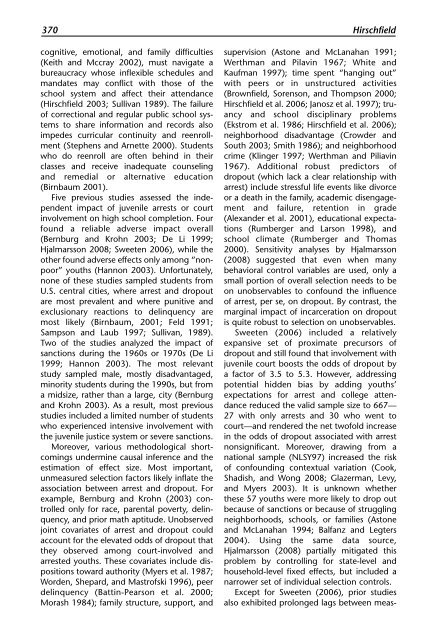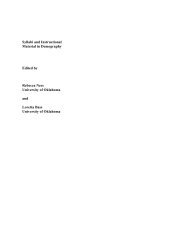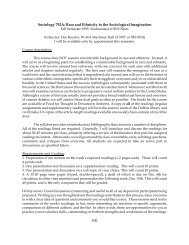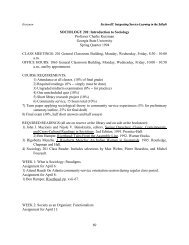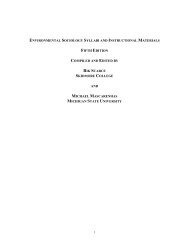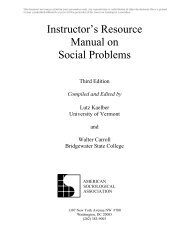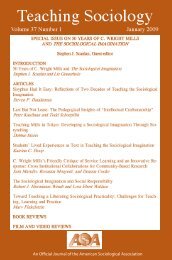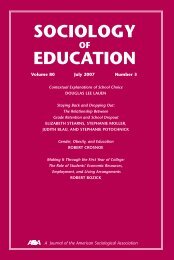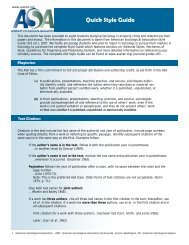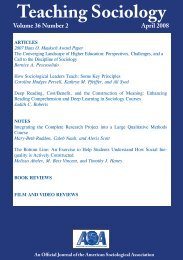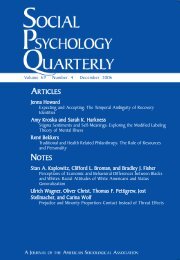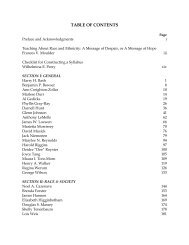SOCIOLOGY EDUCATION - American Sociological Association
SOCIOLOGY EDUCATION - American Sociological Association
SOCIOLOGY EDUCATION - American Sociological Association
Create successful ePaper yourself
Turn your PDF publications into a flip-book with our unique Google optimized e-Paper software.
370 Hirschfield<br />
cognitive, emotional, and family difficulties<br />
(Keith and Mccray 2002), must navigate a<br />
bureaucracy whose inflexible schedules and<br />
mandates may conflict with those of the<br />
school system and affect their attendance<br />
(Hirschfield 2003; Sullivan 1989). The failure<br />
of correctional and regular public school systems<br />
to share information and records also<br />
impedes curricular continuity and reenrollment<br />
(Stephens and Arnette 2000). Students<br />
who do reenroll are often behind in their<br />
classes and receive inadequate counseling<br />
and remedial or alternative education<br />
(Birnbaum 2001).<br />
Five previous studies assessed the independent<br />
impact of juvenile arrests or court<br />
involvement on high school completion. Four<br />
found a reliable adverse impact overall<br />
(Bernburg and Krohn 2003; De Li 1999;<br />
Hjalmarsson 2008; Sweeten 2006), while the<br />
other found adverse effects only among “nonpoor”<br />
youths (Hannon 2003). Unfortunately,<br />
none of these studies sampled students from<br />
U.S. central cities, where arrest and dropout<br />
are most prevalent and where punitive and<br />
exclusionary reactions to delinquency are<br />
most likely (Birnbaum, 2001; Feld 1991;<br />
Sampson and Laub 1997; Sullivan, 1989).<br />
Two of the studies analyzed the impact of<br />
sanctions during the 1960s or 1970s (De Li<br />
1999; Hannon 2003). The most relevant<br />
study sampled male, mostly disadvantaged,<br />
minority students during the 1990s, but from<br />
a midsize, rather than a large, city (Bernburg<br />
and Krohn 2003). As a result, most previous<br />
studies included a limited number of students<br />
who experienced intensive involvement with<br />
the juvenile justice system or severe sanctions.<br />
Moreover, various methodological shortcomings<br />
undermine causal inference and the<br />
estimation of effect size. Most important,<br />
unmeasured selection factors likely inflate the<br />
association between arrest and dropout. For<br />
example, Bernburg and Krohn (2003) controlled<br />
only for race, parental poverty, delinquency,<br />
and prior math aptitude. Unobserved<br />
joint covariates of arrest and dropout could<br />
account for the elevated odds of dropout that<br />
they observed among court-involved and<br />
arrested youths. These covariates include dispositions<br />
toward authority (Myers et al. 1987;<br />
Worden, Shepard, and Mastrofski 1996), peer<br />
delinquency (Battin-Pearson et al. 2000;<br />
Morash 1984); family structure, support, and<br />
supervision (Astone and McLanahan 1991;<br />
Werthman and Pilavin 1967; White and<br />
Kaufman 1997); time spent “hanging out”<br />
with peers or in unstructured activities<br />
(Brownfield, Sorenson, and Thompson 2000;<br />
Hirschfield et al. 2006; Janosz et al. 1997); truancy<br />
and school disciplinary problems<br />
(Ekstrom et al. 1986; Hirschfield et al. 2006);<br />
neighborhood disadvantage (Crowder and<br />
South 2003; Smith 1986); and neighborhood<br />
crime (Klinger 1997; Werthman and Piliavin<br />
1967). Additional robust predictors of<br />
dropout (which lack a clear relationship with<br />
arrest) include stressful life events like divorce<br />
or a death in the family, academic disengagement<br />
and failure, retention in grade<br />
(Alexander et al. 2001), educational expectations<br />
(Rumberger and Larson 1998), and<br />
school climate (Rumberger and Thomas<br />
2000). Sensitivity analyses by Hjalmarsson<br />
(2008) suggested that even when many<br />
behavioral control variables are used, only a<br />
small portion of overall selection needs to be<br />
on unobservables to confound the influence<br />
of arrest, per se, on dropout. By contrast, the<br />
marginal impact of incarceration on dropout<br />
is quite robust to selection on unobservables.<br />
Sweeten (2006) included a relatively<br />
expansive set of proximate precursors of<br />
dropout and still found that involvement with<br />
juvenile court boosts the odds of dropout by<br />
a factor of 3.5 to 5.3. However, addressing<br />
potential hidden bias by adding youths’<br />
expectations for arrest and college attendance<br />
reduced the valid sample size to 667—<br />
27 with only arrests and 30 who went to<br />
court—and rendered the net twofold increase<br />
in the odds of dropout associated with arrest<br />
nonsignificant. Moreover, drawing from a<br />
national sample (NLSY97) increased the risk<br />
of confounding contextual variation (Cook,<br />
Shadish, and Wong 2008; Glazerman, Levy,<br />
and Myers 2003). It is unknown whether<br />
these 57 youths were more likely to drop out<br />
because of sanctions or because of struggling<br />
neighborhoods, schools, or families (Astone<br />
and McLanahan 1994; Balfanz and Legters<br />
2004). Using the same data source,<br />
Hjalmarsson (2008) partially mitigated this<br />
problem by controlling for state-level and<br />
household-level fixed effects, but included a<br />
narrower set of individual selection controls.<br />
Except for Sweeten (2006), prior studies<br />
also exhibited prolonged lags between meas-


